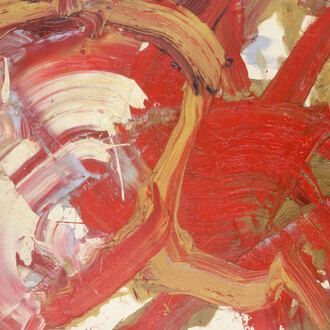I said to him ‘You (Kanayama) seem to like cold abstraction, so why don’t you explore the extremities of that? I like hot abstraction, so I’ll explore the opposite extreme’. We promised to do that and said ‘You are here, I am here’. And that is how I conceived the theory of Plus-Minus.
(Kazuo Shiraga)
Featuring revolutionary robot paintings by Akira Kanayama (1924-2006) and foot paintings by Kazuo Shiraga (1924-2008) Fergus McCaffrey Tokyo is proud to present an exhibition that celebrates the centennial of the birth of both Gutai artists. Plus-minus focuses on both artists’ highly individualistic and innovative methods of painting that fulfilled the Gutai mantra of “Making art that has never been seen before”.
Kanayama and Shiraga were born in Amagasaki, Japan and were friends from childhood. Both aspired to be artists and studied art theory together in the late 1940s before forming the avant-garde collective Zero Society in 1952 (along with Saburo Murakami and later Atsuko Tanaka). They exhibited their works together in 1954, featuring Kanayama’s reduc ve Mondrian-like geometric lines and Shiraga’s early finger and foot pain ngs, which prompted Shiraga’s Plus-minus philosophy of art.
The avant-garde nature of Kanayama’s minimalist conceptualism and Shiraga’s maximalist expressionism attracted the attention of Jiro Yoshihara in early 1955 who invited both artists to join the Gutai Arist Association (along with Saburo Murakami and Atsuko Tanaka); and the former members of Zero Society rapidly became the leading lights of Gutai, as they explored interactive and performance art in the open air and on the stage between 1955-57.
The mature styles of both artists' paintings were fully formed before joining the Gutai Group in 1955, and as pain ng came to the fore in Gutai beginning around 1957, Kanayama continued his focus on removing the artists gesture while Shiraga emphasizing and amplifying it. Shiraga’s first large-scale foot pain ngs made while swinging from a rope emerged in 1956, and Kanayama's first mechanical pain ngs made with battery powered remote control children’s cars that he adapted to carry pens or punctured cans of paint in 1957.















